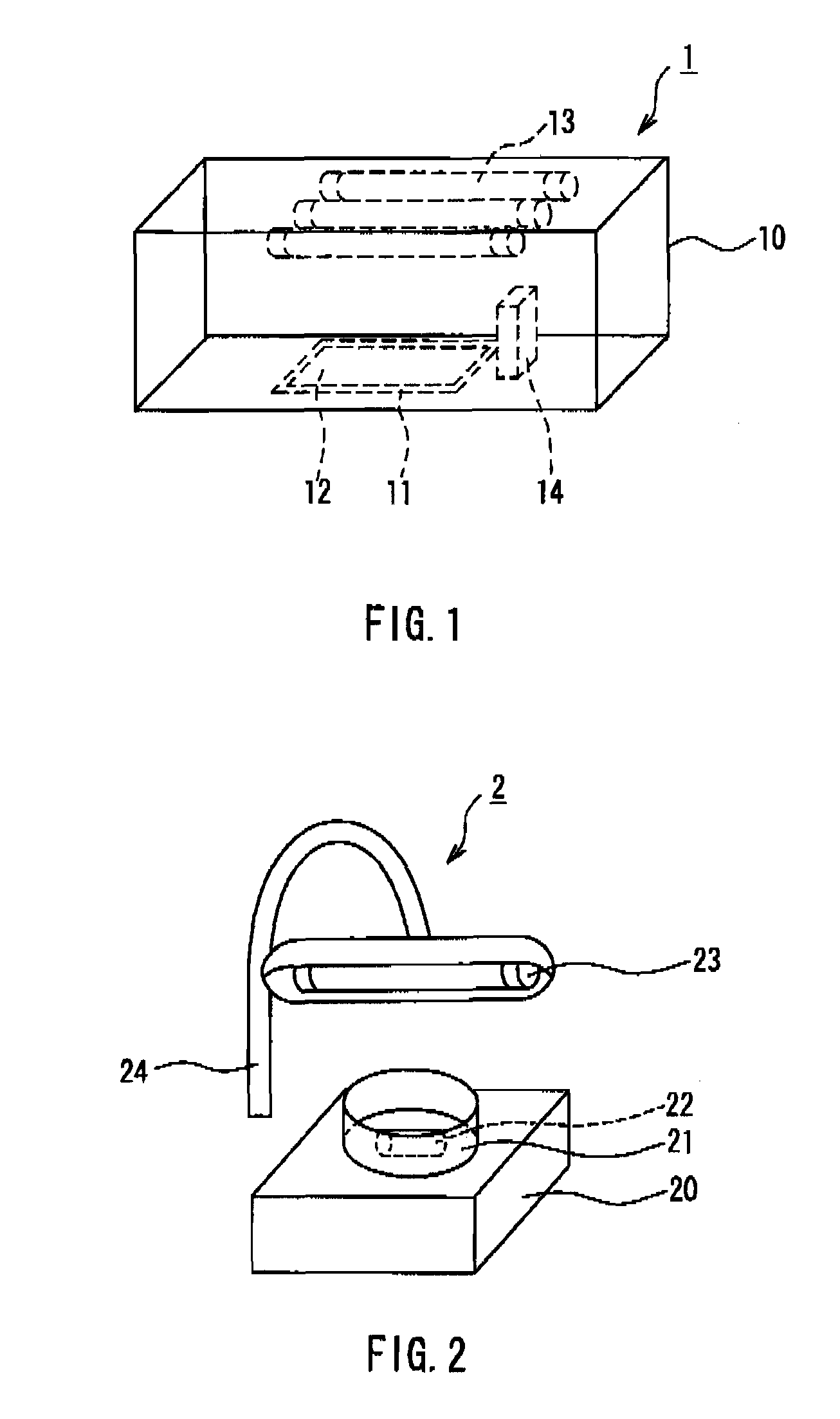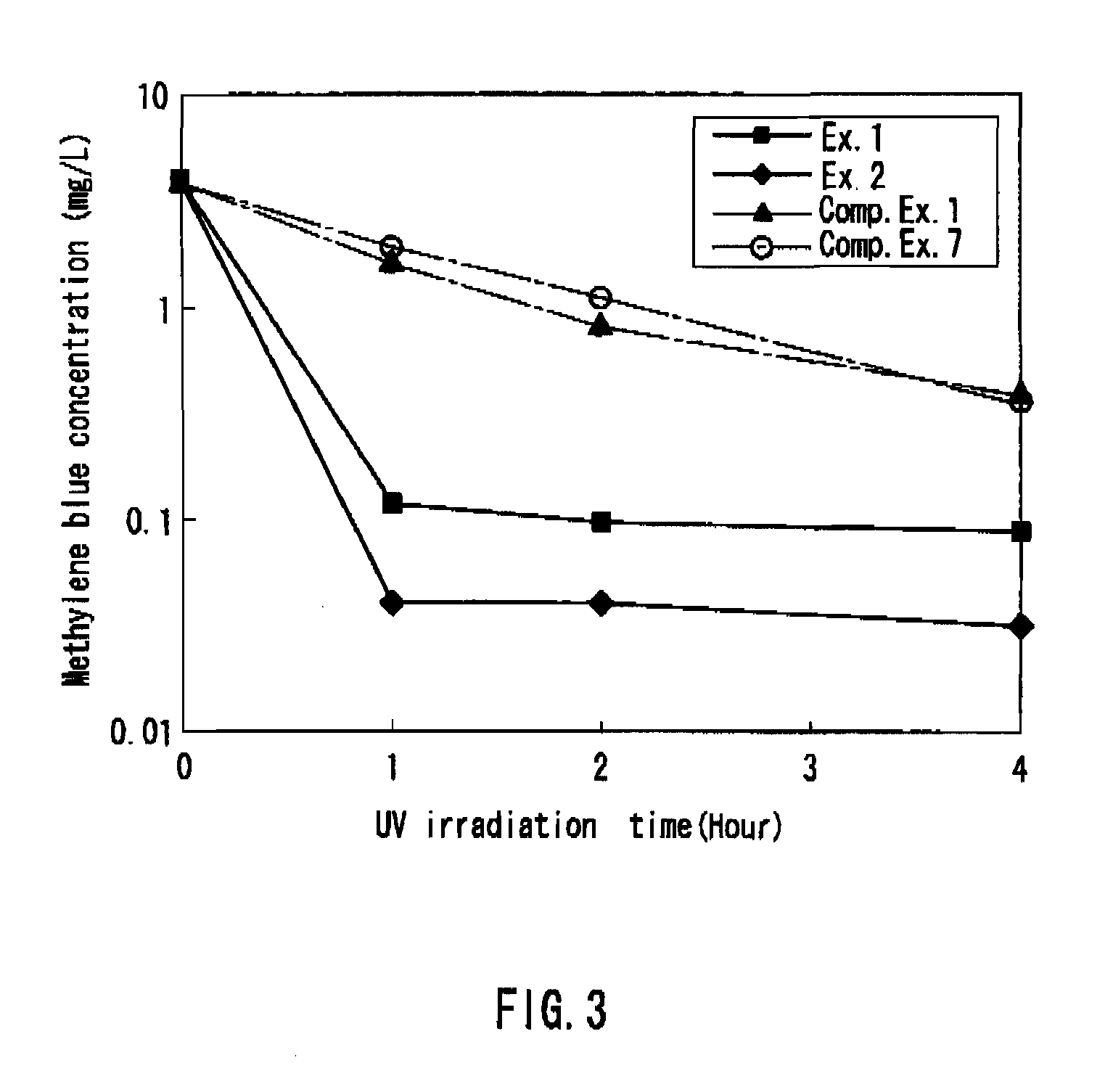Titanium oxide photocatalyst and method for producing the same
- Summary
- Abstract
- Description
- Claims
- Application Information
AI Technical Summary
Benefits of technology
Problems solved by technology
Method used
Image
Examples
use embodiment 1
[0067]FIG. 1 is a perspective view of an air purification module using the titanium oxide photocatalyst of the present invention. As shown in FIG. 1, an air purification module 1 includes a container 10, a substrate 11 provided on a bottom face of the container 10, a titanium oxide photocatalyst 12 formed on the substrate 11, black lights 13 disposed in the container 10 so as to face the titanium oxide photocatalyst 12, and a fan 14 for blowing odorous components in the container 10 toward the titanium oxide photocatalyst 12.
[0068]The substrate 11 is not limited particularly, and a substrate made of a metal, a resin, glass, ceramics, paper or the like may be used. The shape of the substrate is not limited to a flat shape, and any of various types such as a honeycomb form or a filter form may be selected depending on the deodorization method.
[0069]The titanium oxide photocatalyst 12 may be in a form of a layer or a film having a certain thickness. Besides, since the photocatalytic re...
use embodiment 2
[0072]FIG. 2 is a perspective view of a liquid purification module using the titanium oxide photocatalyst of the present invention. As shown in FIG. 2, the liquid purification module 2 includes a magnetic stirrer 20, a Petri dish 21 disposed on the magnetic stirrer 20, a stirrer bar 22 disposed in the Petri dish 21, black light 23 disposed so as to face the Petri dish 21, and a stand 24 that holds the black light 23.
[0073]The liquid purification module 2 is used in the following manner. First, a slurry (not shown) containing the titanium oxide photocatalyst and a liquid-form organic substance is fed to the Petri dish 21, and the slurry is stirred with the stirrer bar 22 rotated by the magnetic stirrer 20. At the same time, the black light 23 irradiates the slurry with light having a wavelength of 400 nm or less. In this way, the liquid-form organic substance can be decomposed.
example 1
[0075]A solution of titanyl sulfate (manufactured by SAKAI Chemical Industry Co., Ltd.) in which the concentration as to titanium oxide was 100 g / L and the concentration as to sulfuric acid was 250 g / L was kept at 100° C. for 3 hours to be hydrolyzed thermally. The pH of the obtained slurry aqueous solution was adjusted with ammonia water until the pH became 8.0, and was filtered. Then, the substance obtained by filtration was washed thoroughly with water to remove salts as impurities. Here, the water washing was performed until the electric conductivity of the washing liquid became 200 μS / cm. Pure water was added to the cake thus obtained so that the concentration of the titanium oxide therein would become 150 g / L, and was stirred, whereby a re-dispersion solution of the titanium oxide was prepared. After that, a hydrofluoric acid (manufactured by Wako Pure Chemical industries, Ltd., guaranteed reagent) equivalent to 5.0 wt % in terms of fluorine (element) with respect to titanium ...
PUM
| Property | Measurement | Unit |
|---|---|---|
| Electrical conductivity | aaaaa | aaaaa |
| Specific surface area | aaaaa | aaaaa |
| Molality | aaaaa | aaaaa |
Abstract
Description
Claims
Application Information
 Login to View More
Login to View More - Generate Ideas
- Intellectual Property
- Life Sciences
- Materials
- Tech Scout
- Unparalleled Data Quality
- Higher Quality Content
- 60% Fewer Hallucinations
Browse by: Latest US Patents, China's latest patents, Technical Efficacy Thesaurus, Application Domain, Technology Topic, Popular Technical Reports.
© 2025 PatSnap. All rights reserved.Legal|Privacy policy|Modern Slavery Act Transparency Statement|Sitemap|About US| Contact US: help@patsnap.com



